Parental Distraction Due To Electronic Devices: Source Of Injuries And Risk-Taking Behaviours Of Children In Playgrounds

Research shows that parents and caregivers are almost always distracted when taking care of children. A large source of the distraction comes from being engaged in electronic devices whilst supervising the kids. Experts now recommend all caregivers to be more watchful and focus on children’s safety, particularly in the playground.
According to the Consumer Product Safety Commission, approximately more than 200,000 children aged between 14 years and below are admitted to US emergency departments due to sustained injuries in playgrounds. Previous studies, like the one published in the Journal of Pediatric Psychology, show that distracted parents are less likely to provide supervision to their kids. At present, electronic devices are increasingly becoming significant distractions for parents. Specifically, the impact of parental distraction had not been delved into in the past.
In a new study conducted by two researchers from different departments in the Cohen Children's Medical Center (CCMC), New York, caregivers and parents were observed whilst accompanying kids to seven playgrounds in New York. They also took note of the children's tendencies to carry out risks in the face of distracted caregivers. Caregivers with one child aged between 18 months and five years were randomly selected and observed throughout the experiment. A researcher then observed the caregiver for 10 to 20 minutes and took note of the different types of distractions that occurred every two minutes. The types of distraction which the researchers focused on include visual guidance, auditory supervision and commitment to looking after the kids and distraction. The other researcher focused on how often the child took a chance at risky behavioural acts.
A total of 371 episodes lasting two minutes each were recorded by the researchers from 50 child-caregiver pairs. It was found that 74 per cent of the caregivers were distracted whilst supervising the kids in the playground. The distractions, however, were mild and most of the caregivers had their focus on the children. Thirty-three per cent of the distractions came from talking with other adults, 30 per cent from using electronic devices and the remaining 37 per cent came from eating drinking reading, looking inside a book bag and other tasks.
"Caregivers in general are doing a fine job supervising their children on the playground. However, increased awareness of limiting electronic distractions and other activities that may interfere with supervision should be considered," noted study author Ruth Milanaik, DO, director of the neonatal neurodevelopmental follow-up program at Cohen Children's Medical Center, or CCMC, New York.
The researcher who observed the behaviours exhibited by the children found that 30 per cent resorted to risky actions such as throwing sand, walking up the slides, pushing, sliding head first and jumping off high swings. Although none of the kids got seriously injured, five falls occurred. It was noted that the children took the risky behaviours when their caregivers were distracted.
Children almost always take risks at play, regardless if their caregivers are distracted or not. Nonetheless, the chances of them engaging in such acts are higher when the caregivers are distracted, said study author Anna Krevskaya, fellow in the Developmental and Behavioral Pediatrics Department at CCMC.
Milanaik adds that aside from limiting distractions, caregivers should also educate the child about the correct use of playground equipment to promote safe play. Injuries can not be halted completely as kids explore and learn through play; however, exerting efforts to keep the level of injuries to a minimum is of utmost value, Milanaik closes.
To contact the writer, email rinadoctor00@gmail.com





















